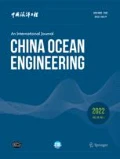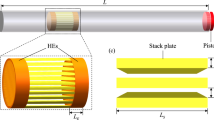Abstract
Flow-induced vibration energy harvesting devices typically use an elastically supported body immersed in an oncoming flow to convert the sea and river current’s hydrokinetic energy into electrical energy. The proportion of energy the device collects is greatly influenced by parameters such as the water flow velocity, spacing between device components, structure size, and damping coefficient. For parameter optimization and performance predictions of flow-induced vibration energy harvesting devices, we train a model of the power harvesting efficiency under different damping ratios, stiffnesses, spacing ratios, and reduced velocities based on experimental data. To improve the prediction accuracy, a feedforward network structure is optimized by using the topological evolutionary algorithm and a radial basis function network. Comparative analysis reveals that the radial basis function network model provides the best agreement with the experimental results and realizes accurate predictions of the power harvested by a dual-oscillator system in the vortex-induced vibration, transition region, and galloping. The prediction results show that the model’s maximum power harvesting efficiency occurs in the vortex-induced vibration. The efficiency increases and then decreases with increasing stiffness and reduced velocity in this phase; an increase in the spacing ratio causes the efficiency to decrease and then increase; finally, increasing the damping ratio enhances the efficiency. The device achieves maximum power harvesting efficiency at a reduced velocity of Ur=4.11. The proposed model effectively predicts the maximum efficiency and the corresponding damping ratio and stiffness of the vortex-induced vibration and galloping, providing a new method for predicting tandem dual-oscillator hydrodynamic power conversion in flow-induced vibration.
Similar content being viewed by others
References
Bernitsas, M.M., 2016. Harvesting energy by flow included motions, in: Dhanak, M.R. and Xiros, N.I. (eds.), Springer Handbook of Ocean Engineering, Springer, Cham.
Bernitsas, M.M. and Raghavan, K., 2011. Enhancement of Vortex Induced Forces and Motion Through Surface Roughness Control, US Patent 8047232.
Bin, P., 2015. Study of Balancing Vehicle Based on Evolving Neural Networks through Augmenting Topologies, MSc. Thesis, Southwest University of Science and Technology, Mianyang. (in Chinese)
Chang, C.C., Kumar, R.A. and Bernitsas, M.M., 2011. VIV and galloping of single circular cylinder with surface roughness at 3.0×104⩽ Res⩽1.2×105, Ocean Engineering, 38(16), 1713–1732.
Ding, L., Zhang, L., Kim, E.S. and Bernitsas, M.M., 2015. URANS vs. experiments of flow induced motions of multiple circular cylinders with passive turbulence control, Journal of Fluids and Structures, 54, 612–628.
Han, X.X., Wu, J.M., Meng, Z.B., Fu, F., Gu, J. and Qiu, A., 2021. Numerical simulation of vortex-induced vibration characteristics of rough riser, Shipbuilding of China, 62(4), 166–179. (in Chinese)
Khan, M.J., Bhuyan, G., Iqbal, M.T. and Quaicoe, J.E., 2009. Hydrokinetic energy conversion systems and assessment of horizontal and vertical axis turbines for river and tidal applications: a technology status review, Applied Energy, 86(10), 1823–1835.
Kim, E.S. and Bernitsas, M.M., 2016. Performance prediction of horizontal hydrokinetic energy converter using multiple-cylinder synergy in flow induced motion, Applied Energy, 170, 92–100.
Lee, J.H. and Bernitsas, M.M., 2011. High-damping, high-Reynolds VIV tests for energy harnessing using the VIVACE converter, Ocean Engineering, 38(16), 1697–1712.
Lee, J.H., Xiros, N. and Bernitsas, M.M., 2011. Virtual damper-spring system for VIV experiments and hydrokinetic energy conversion, Ocean Engineering, 38(5–6), 732–747.
Li, X.C., Xu, W., Zhou, X.L., and Zhao, L.P., 2018. Experimental study on hydrodynamic and power characteristics of vortex-induced vibration based power generator, Journal of Zhejiang University (Engineering Science), 52(7), 1370–1375. (in Chinese)
Lian, J.J., Yan, X. and Liu, F., 2018. Development and prospect of study on the energy harness of flow-induced motion, South-to-North Water Transfers and Water Science & Technology, 16(1), 176–188. (in Chinese)
Liu, F., Xing, S.Q., Yan, X. and Zhang, J., 2017. Experimental investigation on flow induced motion of single degree-of-freedom two tandem circular cylinders, Water Resources and Power, 35(6), 81–84. (in Chinese)
Stanley, K.O. and Miikkulainen, R., 2002. Evolving neural networks through augmenting topologies, Evolutionary Computation, 10(2), 99–127.
Sun, H., Kim, E.S., Bernitsas, M.P. and Bernitsas, M.M., 2015. Virtual spring-damping system for flow-induced motion experiments, Journal of Offshore Mechanics and Arctic Engineering, 137(6), 061801.
Sun, H., Kim, E.S., Nowakowski, G., Mauer, E. and Bernitsas, M.M., 2016. Effect of mass-ratio, damping, and stiffness on optimal hydrokinetic energy conversion of a single, rough cylinder in flow induced motions, Renewable Energy, 99, 936–959.
Sun, H., Ma, C.H., Kim, E.S., Nowakowski, G., Mauer, E. and Bernitsas, M.M., 2017. Hydrokinetic energy conversion by two rough tan-dem-cylinders in flow induced motions: Effect of spacing and stiffness, Renewable Energy, 107, 61–80.
Wang, G.G. and Shan, S., 2007. Review of metamodeling techniques in support of engineering design optimization, Journal of Mechanical Design, 129(4), 415–426.
Wu, W.H., Sun, H., Lv, B.C. and Bernitsas, M.M., 2018. Modelling of a hydrokinetic energy converter for flow-induced vibration based on experimental data, Ocean Engineering, 155, 392–410.
Xiong, Y.M., Zhang, Z.Z., Gao, Y., Peng, G., Liu, L.M. and Yang, B., 2021. Numerical study of the effects of surface roughness on vortex-induced vibration response of a circular cylinder near a plane wall, Journal of Vibration and Shock, 40(20), 108–116, 134. (in Chinese)
Zhao, C.S., 2018. Development Model of Two Wheeled Self Balancing Robot Based on MDB, MSc. Thesis, North China University of Science and Technology, Tangshan. (in Chinese)
Zhu, H.J., Gao, Y., Hu, J., Zhao, H.L. and Bao, Y., 2022. Temporal-spatial mode competition in slug-flow induced vibration of catenary flexible riser in both in plane and out of plane, Applied Ocean Research, 119, 103017.
Zhu, H.J., Li, G.M. and Wang, J.L., 2020. Flow-induced vibration of a circular cylinder with splitter plates placed upstream and downstream individually and simultaneously, Applied Ocean Research, 97, 102084.
Zhu, H.J., Zhao, Y. and Zhou, T.M., 2018. CFD analysis of energy harvesting from flow induced vibration of a circular cylinder with an attached free-to-rotate pentagram impeller, Applied Energy, 212, 304–321.
Author information
Authors and Affiliations
Corresponding author
Additional information
Foundation item
The study was financially supported by the Natural Science Foundation of Jiangsu Province (Grant No. BK20211342), the Jiangsu Province “Six Talents Peak” High-level Talents Support Project (Grant No. 2018-KTHY-033), the National Natural Science Foundation of China (Grant Nos. 51879125 and 51609053) and the Vortex Hydro Energy, Inc. and the U.S. Department of Energy (Grant No. DE-EE0006780).
Rights and permissions
About this article
Cite this article
Bai, X., Sun, M., Han, Cy. et al. Prediction Model of Kinetic Energy Conversion of Tandem Dual-Oscillator Based on Flow-Induced Vibration Experiment. China Ocean Eng 36, 707–719 (2022). https://doi.org/10.1007/s13344-022-0063-2
Received:
Revised:
Accepted:
Published:
Issue Date:
DOI: https://doi.org/10.1007/s13344-022-0063-2




